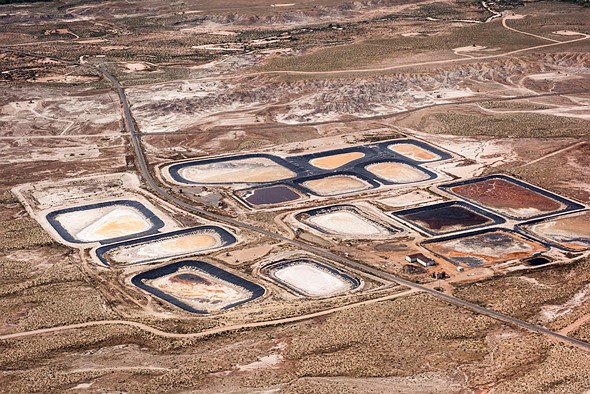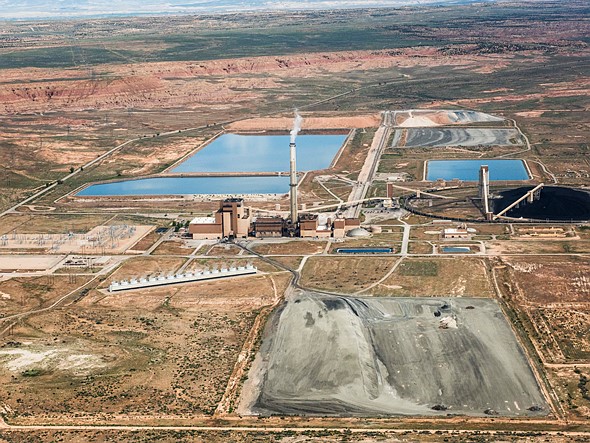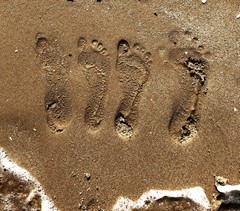 |
|
The White River winds its way through the Uinta Basin in northeast Utah. Fracking sites, the Deseret Power Plant and the Uinta Mountains in the background. Photo: Russel Albert Daniels |
Russel Albert Daniels' aerial landscapes of the Uinta Basin are stunning, but if you spend a bit of time with the photographs, you will realize they reveal a much darker reality. His project, Mother Wound, takes a bird's eye view of the environmental damage that the fossil fuel industry has caused to the region – an area that includes the White River, which is a crucial watershed for the Colorado River.
Daniels has spent the last two years working with nonprofit publications like Mother Jones, ProPublica and High Country News to capture the work. “Flying in a plane is not cheap, so none of this would have happened without all these nonprofit organizations,” he says.
Here, he talks with us about the challenges and benefits of shooting from the sky, and how this particular perspective is valuable for environmental stories.
Why was an aerial perspective an important journalistic tool for this particular story?
I think a lot of people have a romanticized image of what the West is—it's a pretty landscape that’s unharmed. But a lot of the environmental degradation is happening in areas you just can't see, and it's large-scale. Having aerial access allows you to see the full picture. You don't really get to see it when you're on the ground sitting at that pump jack, you still really can't see how many acres, hundreds of square miles of public land are being leased out to oil and gas companies.
I'm definitely not the first person to go on a plane and take photos of similar circumstances, so I knew the power of the photograph from the air. I wanted the work to draw people in by its beauty, but then, as they sat and looked at the photo, to start realizing what’s going on here – and it’s kind of a shocker. What’s hidden underneath the beauty is the reality of mineral extraction.
 |
|
Fracking wastewater evaporation pools above the White River in the Uinta Basin in northeast Utah. Photo: Russel Albert Daniels |
What are the benefits of shooting from the Cessna rather than using a drone?
A drone is an incredible tool for journalism – it's affordable and pretty easy to use, but it has limitations. You can only fly to a particular height, it has a wide-angle perspective, and you usually see the horizon line. With the plane, we’re typically 1500 feet above ground, and as the photographer, it gives me the ability to use wide-angle lenses and telephoto lenses to zoom in and reveal more details.
I made a decision not to become a drone pilot. It’s a whole other class of photography that I'm not interested in getting into at this point. I feel like my talents and my skills are still photography. Another advantage of flying in a plane is that you can simply cover hundreds of miles within a few hours.
What challenges came with photographing from the window of the Cessna?
There are a few challenges. I’m working with nonprofit news organizations to do this work, and we reach out to nonprofit aviation services that often have funding to allow journalists to use their pilots and airplanes, often at no charge. The first challenge is having a good enough story that it's worthwhile for someone to use their resources and get us in the air. As a photographer, ideally, I want to go at particular times when the light is the best, but sometimes you are shooting in the overhead sun, which doesn't make for the most beautiful images.
Once you are on the plane you have to make the decision of where you want to sit. The passenger seat up front means you might be able to shoot out the window, but you really only have one or two angles to shoot from. You might get a plane with a seat in the back; if you sit there, you can shoot from either side, but shooting with my camera against the closed window can mean getting images with a lot of glare.
 |
|
Russel Albert Daniels shooting from the window of a Cessna plane. Photo: Bear Guerra |
Is there particular gear that you like to bring along on these shoots?
There are these big rubber hoods that are real floppy, that go over your lens, and you just plop it up against the window. That eliminates a lot of the reflection and glare. Wearing all black really helps, too, since it’s the white objects on the plane’s interior that show up.
I like to have two camera bodies, one with a 24-70mm lens and a second with either an 80-200mm or an 110mm prime lens. I do find that I like to zoom in and capture a tighter detail when shooting these images. I'm often eliminating the horizon line in some of these images, which almost automatically creates abstract images. When you remove the horizon, you lose that sense of reality. The abstraction allows for more of an impact when people finally get the bigger picture.
 |
|
Fracking sites near the White River in the Uinta Basin in northeast Utah. Photo: Russel Albert Daniels |
How long are you typically up in the air?
These flights are often about three hours, and I’m definitely shooting for about 2-2.5 hours. My wrists are so tired by the end, but I’ve got to take advantage of the time. There's also just a lot of interesting things to see up there, so I'm going to get a shot, even if it's not particular to the story I'm working on.
Why is it important for you to keep going back and working all the angles of this particular story?
The climate crisis we're mitigating right now, it's evident, it's here and all the science has been pointing at it for a long time. It's a little slower than we were scared about it being. It didn’t come as fast or as some big apocalyptic nightmare. It's just a slow, ongoing dread that we are dealing with. The apocalypse is slow, and you still have to go to work.
I think it's important to show people the world and views of these landscapes that show the harm and the destruction that mineral extraction is doing because it's affecting us now. You can look at why that's happening and we can see that these oil and gas corporations and politicians are in bed together, and they are denying the wishes of many, many citizens to find other alternatives to this. We're going to continue to have problems no matter what, but this is obvious. Science has pointed this out. We're seeing the effects, and it's time to change it. If not, we're doomed.
 |
|
Coal-powered Deseret Power Plant in Bonanza, Utah. The power plant was built in anticipation of the production of oil shale in the Uinta Basin. Photo: Russel William Daniel |
The photos are beautiful and abstract, but there’s an undeniable sadness in them. Do you find yourself needing time to reset and process after working on the project?
Yes, all the time. A lot of my work is done with the Native American territories and reservations that are suffering the most; it’s happening on their land or just adjacent to it in their ancestral territories. So I'm also dealing with that trauma that's just being passed through. It's not just the climate, it's people too. And it's not just native people, it's often just rural communities that happen to be next to these mineral extraction sites.
I don't always deal with it the best way. Sometimes I just try to forget about it. Having Native American ancestry, I do have tools to ceremony and different personal practices and community practices that I’m able to do that recenter me. Sometimes, having a beer helps in the short term. Talking about it with other people and friends helps too. The work is also healing in its own right. Showing what’s going on, showing my frustration with the world, and doing my part to help resolve it.
A photo zine of the Mother Wound work can be purchased through Russel Daniels website. Two of the images from the project were acquired by the Utah Museum of Fine Arts earlier this year and are included in its current exhibition Shaping Landscape: 150 Years of Photography in Utah. The work is also currently on view in downtown Salt Lake City, displayed publicly on the Temporary Museum of Permanent Change’s 14 placards.
























































Comments